Into the Heart of Borneo
Tuesday 7 September 1999 –
Wednesday 22 September 1999
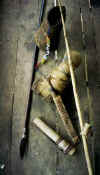 We
had high hopes of catching a glimpse of traditional life in Borneo, but we knew
it wouldn't be easy. As in so many parts of the world, the native
traditions are melting away from one generation to the next. Old-timers
may well have been merry headhunters in their youth, and most adults can
remember when their tribes began to settle in villages and abandon their
communal longhouses; but today's youth are largely addicted to satellite
TV! We knew our best chance to peer back in time would be to get to the
most remote area we could, and in Borneo this means travel upriver, beyond the
rapids and into the mountains of the far interior, where logging roads do not
yet lead. Perhaps the best river to make this attempt, because it's rapids
are so daunting and it's upper reaches so isolated, is the Mahakam.
We
had high hopes of catching a glimpse of traditional life in Borneo, but we knew
it wouldn't be easy. As in so many parts of the world, the native
traditions are melting away from one generation to the next. Old-timers
may well have been merry headhunters in their youth, and most adults can
remember when their tribes began to settle in villages and abandon their
communal longhouses; but today's youth are largely addicted to satellite
TV! We knew our best chance to peer back in time would be to get to the
most remote area we could, and in Borneo this means travel upriver, beyond the
rapids and into the mountains of the far interior, where logging roads do not
yet lead. Perhaps the best river to make this attempt, because it's rapids
are so daunting and it's upper reaches so isolated, is the Mahakam.
Our flight to Samarinda, capital
of East Kalimantan and gateway to the Mahakam, brought new meaning to the concept of baggage
allowance: for the first time in our lives, we were asked to place our
backpacks and ourselves on the scales!
Fortunately, our initial concerns proved unfounded and we did not have to join
our bags in the cargo hold. And we knew this was nothing compared
to the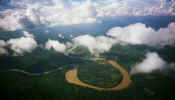 transportation challenges to come: at certain times of the year, the Mahakam River is
un-navigable, either
being too treacherous during the rainy season, when the rapids are ferocious, or
too low in the dry season. Even if
we hit it at the right time of year, we knew it could still be either too hard to
find a guide who would take us, or prohibitively expensive. With hindsight, however, it was to prove to be worth every
uncomfortable night’s sleep, every inedible meal, every bath in the river, and
(possibly) every leech.
transportation challenges to come: at certain times of the year, the Mahakam River is
un-navigable, either
being too treacherous during the rainy season, when the rapids are ferocious, or
too low in the dry season. Even if
we hit it at the right time of year, we knew it could still be either too hard to
find a guide who would take us, or prohibitively expensive. With hindsight, however, it was to prove to be worth every
uncomfortable night’s sleep, every inedible meal, every bath in the river, and
(possibly) every leech.
In Samarinda, we checked into a
hotel and relished the opportunity to take our first hot shower in a while.
We also had the luxury of CNN, which brought us up to date with what was
happening around the world. The
main headlines were filled with events right on our doorstep
in East Timor, and with governments warning their citizens not to travel to
Indonesia, we found hotels almost deserted and 30-50% discounts available for
the asking. It was not until the
Australian forces moved into East Timor that we, as westerners, were to face any
kind of antagonism although our guide, Rustam, was ever vigilant once we were
under his protection.
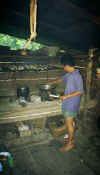 Dr Rustam, as he has been
referred to in various guidebooks, was the person most responsible for making our visit to
Indonesia a life-highlight. He had crossed Borneo
overland, by boat and on foot, no less than three times, and had
obviously inspired confidence in all his tourists based on the glowing reports
given by each. Two days after meeting him, we were off.
Dr Rustam, as he has been
referred to in various guidebooks, was the person most responsible for making our visit to
Indonesia a life-highlight. He had crossed Borneo
overland, by boat and on foot, no less than three times, and had
obviously inspired confidence in all his tourists based on the glowing reports
given by each. Two days after meeting him, we were off.
That evening we motored into Tanjung
Isuy. The main street is a tributary of the Mahakam, and is surrounded by
houses, the odd mosque and occasional side “streets” along each bank.
The cemetery, just inches above the water table at the end of the wet
season, is the highest point in town and even here, bodies apparently have to be
anchored down to prevent them bobbing to the surface after burial (all the
anchors held during our brief stay).
Tanjung Isuy can be a somewhat
touristy place, being the furthest upriver most tourists care to travel, but
since we were the only foreigners in town at the time, we luckily avoided the ritual welcome
dance staged by locals during the high season (for a price, of course)
in an attempt to give visitors a freshly-packaged taste of Dayak culture.
Instead, we heard that a genuine
funeral
ceremony was taking place in a nearby village that night, to which we were
delighted to be invited. It was a
mesmerising evening. Having been
heralded as guests of honor, we were requested to seat ourselves next to the
village headman along one side of the longhouse, and felt exceptionally
conspicuous as he stood up to address the village. 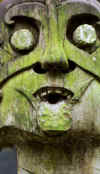 Luckily for us, one of the younger villagers spoke some
English and once the food was served, he came to join us, inviting us to ask
questions about what we saw and translating for the people around him.
He explained to us the rituals that were taking place that evening.
Dayaks believe that the human body has two souls, one that stays with the
dead corpse until the flesh is decomposed, the other that remains in the area of
the village until the necessary rituals are performed that will help send the
soul on its dangerous journey to the Land of the Dead.
Luckily for us, one of the younger villagers spoke some
English and once the food was served, he came to join us, inviting us to ask
questions about what we saw and translating for the people around him.
He explained to us the rituals that were taking place that evening.
Dayaks believe that the human body has two souls, one that stays with the
dead corpse until the flesh is decomposed, the other that remains in the area of
the village until the necessary rituals are performed that will help send the
soul on its dangerous journey to the Land of the Dead.
This secondary ritual takes place once the body has been
buried in an urn or coffin and left to decompose for a period of several months
or even longer. The bones are then
exhumed and prepared for a huge ceremony involving the entire village that may
last for weeks and involve the slaughter of several water buffalo.
Given the cost of such rituals nowadays, joint ceremonies are held
involving several families.
This
renowned second burial ceremony is practiced only amongst two of the many Dayak
tribes in Borneo,
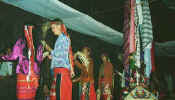 We had arrived the day after the
slaughter of the water buffalo and were to share in eating them that night.
After the formal address by the headman and then dinner, several dances
were to take place, first by the men, then by the women.
The skulls of the deceased were removed from their shrine (which was
surrounded by burning cigarettes to ward off evil spirits, as well as gifts from
villagers intended to placate them) and slung over the shoulders of the men in
brightly coloured cloth. Decked out
in turbans and other elements of traditional dress, the ritual dances took place accompanied by song. We both took our turn in helping the spirits on
their journey to Dayak heaven, hoping that all our incorrect foot movements
would not send them off in the wrong direction!
We had arrived the day after the
slaughter of the water buffalo and were to share in eating them that night.
After the formal address by the headman and then dinner, several dances
were to take place, first by the men, then by the women.
The skulls of the deceased were removed from their shrine (which was
surrounded by burning cigarettes to ward off evil spirits, as well as gifts from
villagers intended to placate them) and slung over the shoulders of the men in
brightly coloured cloth. Decked out
in turbans and other elements of traditional dress, the ritual dances took place accompanied by song. We both took our turn in helping the spirits on
their journey to Dayak heaven, hoping that all our incorrect foot movements
would not send them off in the wrong direction!
The entire ritual was held in the
village longhouse, a massive structure build of hand-hewn wooden planks
suspended on stilts. Historically,
longhouses could reach anything up to a kilometre 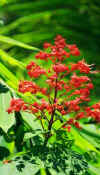 (half-mile)
in length, and housed anything
from a few families to an entire village of several hundred people.
They were raised on posts to provide protection against attack, and such
communal dwelling provided an environment for continuous, informal contact and
harmonious social relations among villagers.
Sadly, after Indonesia’s independence, the new government set about
trying to create a unified Indonesian identity, and Dayaks were encouraged to
abandon their longhouses for more “normal”, single-family dwellings.
Interestingly, however, in the past two decades, the government has
become more sensitive to (and even proud of) the country’s cultural diversity
and development funds are now being used to rebuild many of the longhouses that
had previously been abandoned. Although
some people still live in longhouses in the most remote parts of Kalimantan, for
the most part Dayaks have now become used to separate homes and use their
longhouses as meeting houses although they are still decorated in the true Dayak
style.
(half-mile)
in length, and housed anything
from a few families to an entire village of several hundred people.
They were raised on posts to provide protection against attack, and such
communal dwelling provided an environment for continuous, informal contact and
harmonious social relations among villagers.
Sadly, after Indonesia’s independence, the new government set about
trying to create a unified Indonesian identity, and Dayaks were encouraged to
abandon their longhouses for more “normal”, single-family dwellings.
Interestingly, however, in the past two decades, the government has
become more sensitive to (and even proud of) the country’s cultural diversity
and development funds are now being used to rebuild many of the longhouses that
had previously been abandoned. Although
some people still live in longhouses in the most remote parts of Kalimantan, for
the most part Dayaks have now become used to separate homes and use their
longhouses as meeting houses although they are still decorated in the true Dayak
style.
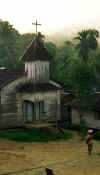 One wonderful memory of that
evening was a conversation we managed to have with one of the village elders
through the younger fellow who spoke English, asking him about the changes he had
seen in his village during his lifetime. He
lamented the fact that people now lived separate lives in separate houses, and
wished they could return to the longhouse to live together under one roof.
Electricity for him was a mixed blessing: artificial light was the
best thing to come along in a generation, but television was corrupting the
young.
One wonderful memory of that
evening was a conversation we managed to have with one of the village elders
through the younger fellow who spoke English, asking him about the changes he had
seen in his village during his lifetime. He
lamented the fact that people now lived separate lives in separate houses, and
wished they could return to the longhouse to live together under one roof.
Electricity for him was a mixed blessing: artificial light was the
best thing to come along in a generation, but television was corrupting the
young.
This experience really whetted
our appetite to learn more about Dayak ways, and the next day we continued our
journey bright and early. After
a couple days of travel by various forms of rickety watercraft, we noticed a distinct change
in the scenery: sheer limestone cliffs and tropical rainforest overhanging
the rocks, all against a backdrop of clear blue sky.
It is in this region, near the town of Long Iram, that the lucrative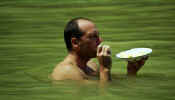 business of searching for the
Chinese delicacy of birds’ nests starts, and the villages become noticeably
more traditional. By nightfall, we
arrived at Long Bagun and after washing at the river bank, accompanied by a
curious crowd of onlookers, we ate yet another unappetizing meal of rice and
fish before settling down for the night in the living room of a local Dayak
family.
business of searching for the
Chinese delicacy of birds’ nests starts, and the villages become noticeably
more traditional. By nightfall, we
arrived at Long Bagun and after washing at the river bank, accompanied by a
curious crowd of onlookers, we ate yet another unappetizing meal of rice and
fish before settling down for the night in the living room of a local Dayak
family.
The next morning, thanks to an
incredible storm during the night, the water level of the river had risen
sufficiently that we were able to find yet another long boat (very large
motorized canoes, and the only form of transportation capable of navigating the
rapids) to take us further into the interior.
Our travelling companions by this time included: several Chinese men,
who were on a business trip in search of as many birds’ nests as they could
find to take back to China; a young couple with two 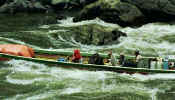 small children who
were going
back to their village at Tiong Ohang to visit family; and several young men we
later learned were in the military. A
hefty cargo of four enormous oil drums were removed to fit everyone and their
luggage on board, and it was with some trepidation that we set off for a long,
uncomfortable journey through the rapids. We
did, however, provide light entertainment throughout the day as the people on
board watched us trying to eat rice with our fingers (obviously the wrong way),
and wriggle fruitlessly in an attempt to find space to put our oversized legs.
Sadly, we were to pass a number of logging camps en route to our next
stopover and saw for ourselves the total devastation caused by loggers across
vast areas of the rainforest.
small children who
were going
back to their village at Tiong Ohang to visit family; and several young men we
later learned were in the military. A
hefty cargo of four enormous oil drums were removed to fit everyone and their
luggage on board, and it was with some trepidation that we set off for a long,
uncomfortable journey through the rapids. We
did, however, provide light entertainment throughout the day as the people on
board watched us trying to eat rice with our fingers (obviously the wrong way),
and wriggle fruitlessly in an attempt to find space to put our oversized legs.
Sadly, we were to pass a number of logging camps en route to our next
stopover and saw for ourselves the total devastation caused by loggers across
vast areas of the rainforest.
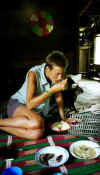 After a scorching hot day and
over nine hours of travel, we were glad when dusk fell, thinking we would surely be
stopping somewhere before night fall. During
the course of the day, we had had to unload the boat three times and hike across
the rocks at the waters edge, while the boat negotiated the more treacherous
rapids which cut off the villages of the Upper Mahakam for much of the year.
With no pit stops or toilet breaks, there was more than one discomfort on
our minds and as dusk fell, a hard rain started to fall, stinging us as
we sped upriver. Even
in the pitch black of night, we continued on our journey, shuddering at the
thought of what we might hit at that speed in the dark, but the Dayak spirits were
merciful and we arrived at Data Dawai, thankful to be in one piece and
never so happy to be able to take a cold water mandi (sponge bath) and sit down to yet another
meal of rice and fish.
After a scorching hot day and
over nine hours of travel, we were glad when dusk fell, thinking we would surely be
stopping somewhere before night fall. During
the course of the day, we had had to unload the boat three times and hike across
the rocks at the waters edge, while the boat negotiated the more treacherous
rapids which cut off the villages of the Upper Mahakam for much of the year.
With no pit stops or toilet breaks, there was more than one discomfort on
our minds and as dusk fell, a hard rain started to fall, stinging us as
we sped upriver. Even
in the pitch black of night, we continued on our journey, shuddering at the
thought of what we might hit at that speed in the dark, but the Dayak spirits were
merciful and we arrived at Data Dawai, thankful to be in one piece and
never so happy to be able to take a cold water mandi (sponge bath) and sit down to yet another
meal of rice and fish.
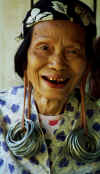 The rain was still falling hard
the following day, but after only three or four hours, we arrived at Tiong Ohang,
the furthest upriver we could get by long boat.
Dripping wet and miserable, we disembarked and checked into a local losmen
(hostel), relieved at the sight of relative civilization.
It didn’t take us long to realise we were now in real Dayak country,
however, as we saw for the first time women with distended earlobes wearing
anything up to 100 hoop earrings. Men
and women alike had the tell-tale red stains of betel nut on their teeth, and the
dirt pathways were riddled with red betel nut spit.
We were greeted with wariness, and for the most part people kept their
distance but were inquisitive to see two white faces in
their village. Once the rain stopped, we ventured out to visit some of the local villagers and were
welcomed into one home to sit and chat with the family while Eric plucked up the
courage to chew his first betel nut: a small parcel consisting of a betel
nut, a sticky lime paste, and a leaf of marijuana carefully wrapped up.
This is popped into the mouth to be chewed slowly over the
course of an hour or more. The nut
causes you to salivate excessively and turns your mouth (and spit) scarlet red.
Whilst in somebody’s house, you discreetly spit into a communal
spittoon, but if out on the street, you simply use the pathway underfoot!
According to Eric, the result is a mellow buzz and a nasty aftertaste (he'll
stick with his pipe).
The rain was still falling hard
the following day, but after only three or four hours, we arrived at Tiong Ohang,
the furthest upriver we could get by long boat.
Dripping wet and miserable, we disembarked and checked into a local losmen
(hostel), relieved at the sight of relative civilization.
It didn’t take us long to realise we were now in real Dayak country,
however, as we saw for the first time women with distended earlobes wearing
anything up to 100 hoop earrings. Men
and women alike had the tell-tale red stains of betel nut on their teeth, and the
dirt pathways were riddled with red betel nut spit.
We were greeted with wariness, and for the most part people kept their
distance but were inquisitive to see two white faces in
their village. Once the rain stopped, we ventured out to visit some of the local villagers and were
welcomed into one home to sit and chat with the family while Eric plucked up the
courage to chew his first betel nut: a small parcel consisting of a betel
nut, a sticky lime paste, and a leaf of marijuana carefully wrapped up.
This is popped into the mouth to be chewed slowly over the
course of an hour or more. The nut
causes you to salivate excessively and turns your mouth (and spit) scarlet red.
Whilst in somebody’s house, you discreetly spit into a communal
spittoon, but if out on the street, you simply use the pathway underfoot!
According to Eric, the result is a mellow buzz and a nasty aftertaste (he'll
stick with his pipe).
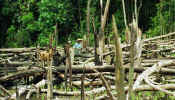 Almost all Dayaks here are
subsistence farmers, and disappear into the forest for days at a time to clear
patches of land with slash and burn techniques in order to cultivate the dry rice
which forms their basic livelihood. Poor
acidic soils, steep slopes and continuous erosion often result in poor yields
and they rely heavily on whatever meat they can catch, which
they hunt down in the jungle with the help of dogs and spear-tipped blowguns.
Our first hand experience of hunting in the jungle with the professionals
was to come in Long Apari, the last and most remote village on the Mahakam.
Our two-day stay in the village fully justified the arduous journey,
yielding remarkable insights into the lives of these
distinctive people.
Almost all Dayaks here are
subsistence farmers, and disappear into the forest for days at a time to clear
patches of land with slash and burn techniques in order to cultivate the dry rice
which forms their basic livelihood. Poor
acidic soils, steep slopes and continuous erosion often result in poor yields
and they rely heavily on whatever meat they can catch, which
they hunt down in the jungle with the help of dogs and spear-tipped blowguns.
Our first hand experience of hunting in the jungle with the professionals
was to come in Long Apari, the last and most remote village on the Mahakam.
Our two-day stay in the village fully justified the arduous journey,
yielding remarkable insights into the lives of these
distinctive people.
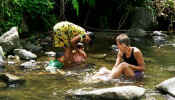 We reached the village by motor
canoe from Tiong Ohang and stayed with one of the villagers, sleeping on rattan
mats on the bare wooden floor, washing in the river and eating yet more rice and
dried fish. Farangs
(foreigners) were a novelty among the village people and our arrival created an enormous stir. Children fled in terror,
having never seen a white person and believing us to be evil spirits, while the
elders kept their distance and enquired of Rustam why we could possibly
We reached the village by motor
canoe from Tiong Ohang and stayed with one of the villagers, sleeping on rattan
mats on the bare wooden floor, washing in the river and eating yet more rice and
dried fish. Farangs
(foreigners) were a novelty among the village people and our arrival created an enormous stir. Children fled in terror,
having never seen a white person and believing us to be evil spirits, while the
elders kept their distance and enquired of Rustam why we could possibly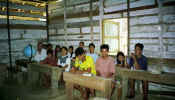 be
interested in visiting their village. Concerned that the children were so scared of little old us, we decided to
visit the school the following morning and try to befriend them.
While Pippa taught them English, Eric gave them a maths lesson and by the
end of the morning, they all agreed to pose for photographs.
be
interested in visiting their village. Concerned that the children were so scared of little old us, we decided to
visit the school the following morning and try to befriend them.
While Pippa taught them English, Eric gave them a maths lesson and by the
end of the morning, they all agreed to pose for photographs.
Meanwhile, we were invited by
the elder boys to go hunting with them, an opportunity we would not have missed
for the world. They had never taken
a woman hunting with them, so they were a little wary of Pippa’s delight in
joining the hunt party, but perhaps her bizarre haircut helped our cause.
We all climbed aboard a canoe, complete with a large pack of dogs, and headed off into the jungle.
What humiliation! As these barefoot hunters effortlessly jumped from rock to bank,
scooted over fallen tree trunks and skirted thorn trees, we
stumbled through the rivers, slid on the mud banks, ripped our shirts and still
couldn’t keep up! Sadly, the hunt
was called off due to heavy rain before we managed to track down any boar
(apparently they can’t hear the dogs above the sound of the rain), so we
returned to the village, empty-handed but invigorated by our jungle adventure.
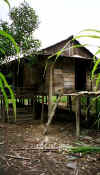
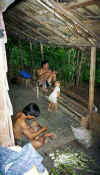
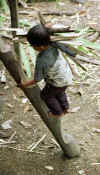
All too soon it was time to
head back to Samarinda, and we reluctantly packed our bags to leave.
In the two days we had been there, the children had begun to view us as a
source of hilarity, unable to control a canoe on the river, struggling to walk
up slippery mud banks and decked out in bizarre footwear.
But as we left, they came running out of the school building to the river
bank to wave us goodbye; it seemed we had finally made some new friends.